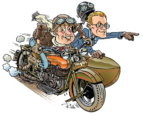Endurance and Reliability Trials have been around since man first installed an engine into a bicycle frame. They are a measure of the riders stamina and the motorcycles ruggedness and reliability.
Both Knobster and myself have competed in such an event, ours being The Grand Challenge organised by Rusty Nuts and the aim was to complete 1000 miles in 24 hours (approx 1600kms). A challenge indeed but compared to events from earlier times they were perhaps a bit of a doddle (just don’t tell my back and arms that). We had more comfortable motorcycles, fairings for some offering better weather protection, improved disc brakes, better electrics with 120W headlights for safer night riding, and sealed roads. Back in 1950 there was 6v electrics with a 24W headlight, slower more demanding roads that would have been unsealed for a good majority of the distance, and oil skin clothing to ward off the cold and wet. Stepping back even further most motorcycles would have used acetylene (gas) lights, the roads would have been even more rougher, speeds slower and entrants would have had to plan their journeys with more precision especially when it came to petrol refuelling stops (read about Gilbert Browns efforts here). So for those older entrants from earlier times 1950 would have been pure luxury.
Reliability Trails were not every motorcyclists interest but for those who did compete any chance of surviving the distance would be as a result of good planning and preparation. Being mindful of all possible situations that could be encountered riders would have to carry an assortment of tools, spare parts like lightbulbs, spark plugs, tubes, a least a throttle and clutch cable, and perhaps a small container of oil. Motorcycles with smaller petrol tanks may even have to carry fuel.
As with any type of riding the weather can be very unpredictable so besides weatherproofing ones motorcycle (oiling of the control cables, ensuring that the rubber weather cups around HT leads are in good condition, electrical connections are tight and perhaps sealed with grease etc) riders would have had to make sure that they were also protected from the worst of conditions.
Perhaps the addition of a handlebar mounted wind screen with a perspex shield and thick canvas lower section could be the go for competitors, but not ideal for the lower powered machines, whose riders would just have to tough it out.
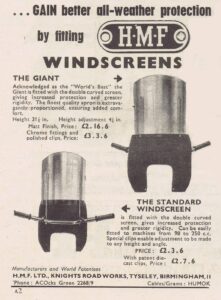
For more personal comfort riders could have worn surplus WW2 trench coats, all good to keep warm on a chilly night but if they became water logged they could carry an extra 20lbs of rain weight for the motorcycle to lug along. This is what they may have invested in if finances had allowed.
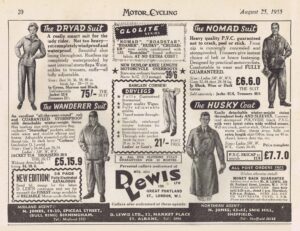
The more up market wet weather riding gear from D Lewis in the UK for 1955.
The John Bull Reliability Trial Origins.
In 1933 the Leicester Rubber Company, who were the manufacturers of John Bull Tyres presented a sterling silver cup to the Auckland Motorcycle Club for the first place competitor in an annual competition for a 24hr reliability trial. The handsome trophy was insured at that time for 25 pounds. In that year George Fletcher and Percy Howlett tied for first place with the loss of 6 points each.
For 1934 the winner was G Howlett with the loss of one point. Percy Fletcher, who was second lost 3 points in the starting test and two at a water splash with Howard Tettey, who lost 6 points in starting and one point in the machine examination coming in at third place.
To try and attract more entries for 1934 it was decided to reduce the trial from 24 hours to 12 hours which may have proven the success that the club wanted as for 1935 the event was back at 24 hours, covering an impressive 530 miles, and had 12 riders entered and finish. The winner for this year was Cyril Goldfinch, with a special mention of N Zamensk who travelled all the way from Napier to compete, and came third. An additional challenge this year was that the competitors were not permitted to use time pieces or speedometers and secret time checks along the route were also imposed.
The winner for 1936, ‘37 and 1938 was John Dale of Auckland.
It would be another 12 years (1950) before the event was run again due to petrol restrictions. For this event there was a First Prize of The John Bull Trophy, 10 pounds prize money and a new tyre. There was additional prizes to a grand total of 25 pounds spread over 4 or 5 other places, with 2 more tyres, a battery and tubes as well.
So how did the 1950 John Bull Reliability Trial finish? This is a report from the 16th December 1950 edition of the N.Z. Motor Cyclist.
L. Fletcher of Hamilton Wins John Bull Trial
Congratulations go to L. Fletcher of Hamilton, a consistent competitor in all types of events, whe rode his Trophy Triumph through to Auckland to compete in and win the Auckland Clubs John Bull 24-hour Trial. Thirty seven riders started in the event, three being from Whakatane, one from Hamilton, one from Kaitaia, two from Pukekohe, six from the North Shore, and two from the Onehunga clubs. Most makes and sizes of machine were represented, the smallest being Bob Dyers 125c.c. Royal Enfield.
The route of over 500 miles, passed through Hamilton and Cambridge to Taupo, where competitiors had a two hour break for tea and a spell, and from there, through Wairakei, Rotorua, and Edgecumbe to Whakatane, arriving there about 1 a.m. for a 40 minute spell.
Leaving Whakatane, riders proceeded to Tauranga for another break of 20 minutes, then on through Waihi and Paeroa to Thames for breakfast. They came home through Waitakaruru, Miranda and Clevedon to Papakura and Auckland. Riding at one minute intervals, competitors were not troubled by dust, and the first rain encountered was at Westfield on the way home.
The results of the event were :
L. Fletcher, 500 Trophy Triumph, 1st, lost 23 points.
J. Mears, 350 A.J.S, 2nd, lost 26 points.
R. Battersby, 350 Matchless, 3rd, lost 29 1/2 points.
D. McGill, 500 Triumph Twin, 4th, lost 31 points.
N. Richard, 500 Matchless, G. Hammond, 500 Triumph, 5th, lost 31 1/2 points.
B. Cardon, 500 Matchless, 7th, lost 33 points.
C. Taylor, 350 A.J.S., C. Oram, 500 A.J.S., 8th, lost 33 1/2 points.
Thirty one riders will receive pennants presented by Mr H. S. White for those who finished.
And this is what would have been awarded – The John Bull Pennant. I wonder how many more of these are still in existence.
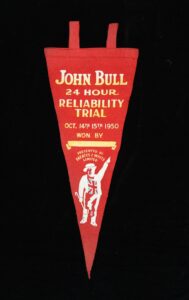
Perhaps special mention should be made of the most adventurous of entrants, that would be Bob Dyer on his Royal Enfield 125 Flying Flea. Most entrants opted for the bigger capacity machines – 350 and 500cc that would have been suitable for such a trial, whereas Bob seemed to want the ultimate challenge on the smallest machine. The wee Enfield was a hangover from the WW2 Parachute Transport Unit and was powered by a whopping 2.1/2 hp 125cc 2 stroke engine of Royal Enfields own design. It had a 3 speed handchange gearbox and girder style front forks sprung with rubber bands (if it was the new 1950 model then it would have had the latest in non dampened telescopic forks). And for night time riding it had a not so powerful Miller 24W headlight that’s brilliance would have been dependant on the engine revs as the lightweight did not have a battery. Weighing in at 139lbs it had a stop speed of 45mph. I am not sure of the outcome of Bobs quest, and even if he was one of the six that didn’t manage to finish a hearty well done would have been in order just for the attempt. My kind of motorcyclist.
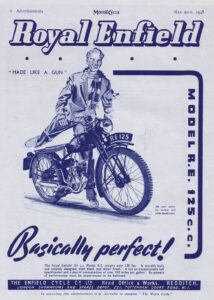
The Royal Enfield 125 that Bob would have ridden.
One week previous to this event the North Shore Motor Cycle Club held the Matchless Cup night trial on the 7th – 8th October. Whether it was used as a warm up for the following weekends John Bull event who knows, but not withstanding it still warranted a full report in the November 27th 1950 edition of the N.Z. Motorcyclist. It reads as follows –
Matchless Cup Night Trial.
The North Shore Motor Cycle Club held the Matchless Cup night trial on the 7th – 8th October.
The trial started at nine o’clock Saturday night riders being sent off from Auckland to the first stop Hamilton. Competitors were checked for a “stop” sign at a railway crossing and at Morrinsville and Matamata.
A stop was made up the Kaimai hill where a fire was available and later an observed section and several questions.
Petrol and breakfast had been arranged in Tauranga after which the route led through to Waiki where another observed section waited this time unfortunately in steady rain. Next stop was for lunch at Paeroa, competitors then being sent off on the main route to Auckland where the trial ended.
Results:
1st: R.R. Salt, lost 26 points (Matchless), 2nd: G. Hammond, lost 44 points, (Velo), 3rd: D. Taylor, lost 52 points (Velo)
And yes for our success in completing the Grand Challenge in 1988 our trophy wasn’t a pennant but still something just as coveted – a badge. Given to only those who completed the run within the 24 hour period. Such fun times.
More information on 1930s John Bull Reliability Trials can be found on New Zealands Papers Past website paperspast.natlib.govt.nz/newspapers and search John Bull Trial.
